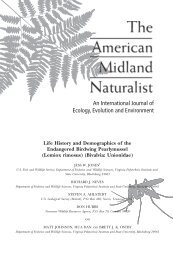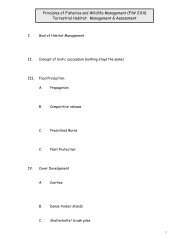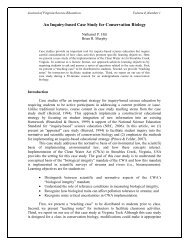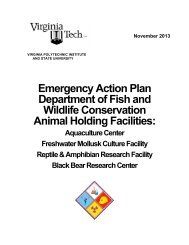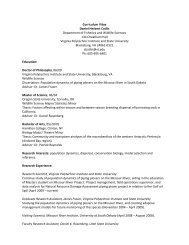Kernel Home Range Estimation for ArcGIS, using VBA - Fish and ...
Kernel Home Range Estimation for ArcGIS, using VBA - Fish and ...
Kernel Home Range Estimation for ArcGIS, using VBA - Fish and ...
You also want an ePaper? Increase the reach of your titles
YUMPU automatically turns print PDFs into web optimized ePapers that Google loves.
4.5. St<strong>and</strong>ardization<br />
Not all datasets are created equal. It is often the case that data will have greater variance in a<br />
particular direction. This may be caused by the behavior of the animal or it may be a result of a<br />
geographic constraint to movement – as might be the case <strong>for</strong> linear barriers such as mountain<br />
ranges, streams or coastlines (<strong>for</strong> terrestrial species). In such cases it may be better to search<br />
further in the direction with the greater variance to find points that will contribute to the density<br />
estimate <strong>for</strong> an evaluation point. Complex kernels are one method of overcoming this bias in the<br />
data, <strong>and</strong> an alternative technique is described in section 4.5.2. A better solution would be to<br />
st<strong>and</strong>ardize the data, run the kernel density analysis (<strong>using</strong> a single smoothing parameter) <strong>and</strong><br />
then re-project the final home range contours to match the original scale of the data. Unit<br />
(Section 4.5.1.) <strong>and</strong> X Variance St<strong>and</strong>ardization (Section 4.5.2.) have been suggested <strong>for</strong> this.<br />
ABODE allows the user to incorporate st<strong>and</strong>ardization in the analysis <strong>using</strong> the a<strong>for</strong>ementioned<br />
methods <strong>and</strong> a thrid option, Covariance Bias (Section 4.5.3).<br />
4.5.1. Unit Variance St<strong>and</strong>ardization<br />
St<strong>and</strong>ardizing data to have a unit covariance matrix was proposed by Silverman (1986). The<br />
original data (Figure 4.5.1.1.a.) are st<strong>and</strong>ardized <strong>using</strong> the variance measures in the x <strong>and</strong> y<br />
directions. The x coordinate <strong>for</strong> each point is divided by the st<strong>and</strong>ard deviation in X (σBxB).<br />
Similarly, y is scaled by σByB. This results in a set of st<strong>and</strong>ardized data (Figure 4.5.1.1.b.). In this<br />
simple example, the relationship between points is preserved, since the variance is equal in both<br />
X <strong>and</strong> Y (Figure 4.5.1.2.a.). In cases where the variance in X <strong>and</strong> Y is not equal (Figure<br />
4.5.1.2.b.), the relationship between the points is altered such that the variance in each direction<br />
is equal. The kernel density estimation would typically be done on the st<strong>and</strong>ardized data to<br />
produce a home range estimate (Figure 4.5.1.3.a.). This allows <strong>for</strong> the use of a single smoothing<br />
factor. The final product would be trans<strong>for</strong>med back to the original scale of the data (Figure<br />
4.5.1.3.b.).<br />
26



